Jul 30, 2010
A Tasting Note: 2009 La Biancara Rosso Masieri
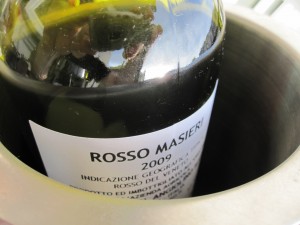 La Biancara di Angiolino Maule
Contrà Biancara 14
Gambellara (Vi)
ITALIA
La Biancara di Angiolino Maule
Contrà Biancara 14
Gambellara (Vi)
ITALIATel: +39 (0) 444 444 244 Annual production: 35,000 – 45,000 bottles
Angiolino Maule owns 11 hectares (& rents 2ha more) of vineyards on volcanic soil between the provinces of Vicenza and Verona, an extension of the Soave foothills in the Veneto, in North Eastern Italy. The Veneto is a region traditionally famous for the Soave white wines and the dark, rich and typically hugely alcoholic Amarone della Valpolicella wines. But Angiolino is traditional in another way, working the vineyards as naturally as possible without the use of any synthetic or chemical additives, industrial fertilizers or any other artificial soil treatments. Rather, he practices biodynamics and uses only natural preparations in the vineyards.
Angiolino’s philosophy is carried through to the cellar where his wines spontaneously ferment with only indigenous yeasts. He doesn’t control temperature during fermentation, he uses no enzymes nor sulfur and bottles without fining or filtering. To quote Angiolino “The big difference between the majority of vine growers and my vine growing is my great respect for nature and that means no compromise. I accept and defend what the land gives me without correcting, adding or subtracting to get more. In the cellar I think the difference is even greater, some producers with the excuse of protecting or enhancing came to use six to eight chemicals added to the must or the wine, I disagree”
Angiolino makes both red and white wines. His whites are made with the Garganega and Trebbiano grapes. The reds are made with Cabernet Sauvignon & Merlot mostly, but also with the Tocai Rosso (Grenache). He is also one of the few in the world who make a natural sweet wine. A wine made with 100% dried Garganega grapes that is fermented with only indigenous yeasts, not filtered or fined and not sulfured. This Recioto is a magnificent accompaniment to cakes and ice cream.
The wine for this tasting note is 100% Merlot.. Yes, Merlot. But, not the jammy, silky 14.5% Merlot we got bombarded with in California in the 80’s & 90’s. This 12.5% Merlot is more reminiscent of something more rustic, something like you might find on the right bank in Bordeaux. No, this is not a Bordeaux, but it’s not your California Merlot Either….read on..
The Merlot grapes for this Rosso Masieri wine come from a single vineyard at the foot of the Gambellara hills. The fermentation occurs in open-top wooden vats with 3-4 punch-downs a day. After the 12-15 day fermentation, the skins are left to macerate with the juice for a further 10 days or so. The wine is then racked to separate the liquid from the must. Then wine is transferred to steel where it rests until bottling. This wine was bottled May 21, 2010.
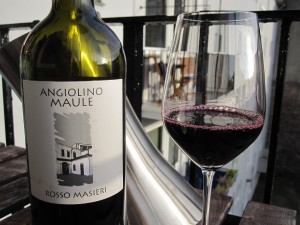 Date Tasted: July 29th, 2010 20:30 (8:30pm)
Date Tasted: July 29th, 2010 20:30 (8:30pm)
Appearance: dark purple with pink edges – very young
Nose: Black currants and green leaves, plums, morel cherries & black berries. Dark fruit dominated. Although I don’t really find any red fruit, the wine smells very fresh and vibrant. Some intriguing green notes, like fresh green peas. Red apples start to emerge at 21:15
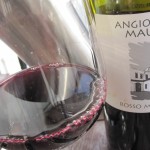 Palate: A slight tingle as the wine hits the tongue, but not CO2, rather minerals that dance on the tongue. Dark fruit dominant with some green notes which I attribute to more of a salty, minerally component. Medium plus intense fruit with medium level tannins. The medium plus acidity carries the wine to a long, salty, mineral finish with slightly dry, bitter tones. Extremely well structured and balanced with well-integrated alcohol. Slight pepper notes also found after a half an hour.
Palate: A slight tingle as the wine hits the tongue, but not CO2, rather minerals that dance on the tongue. Dark fruit dominant with some green notes which I attribute to more of a salty, minerally component. Medium plus intense fruit with medium level tannins. The medium plus acidity carries the wine to a long, salty, mineral finish with slightly dry, bitter tones. Extremely well structured and balanced with well-integrated alcohol. Slight pepper notes also found after a half an hour.
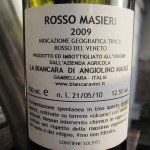 The strong points of this wine are the superb balance and structure. I particularly like the salty, mineral finish which I have come to expect in Maule’s wines. I would have to say that this wine is extremely delicious and drinkable. This is not your ordinary Merlot, rather a true expression of Merlot growing on volcanic soil in the Veneto. And a bargain at around 165 Norwegian Kroner. Oh, did I mention that this wine was mineral? 😉
The strong points of this wine are the superb balance and structure. I particularly like the salty, mineral finish which I have come to expect in Maule’s wines. I would have to say that this wine is extremely delicious and drinkable. This is not your ordinary Merlot, rather a true expression of Merlot growing on volcanic soil in the Veneto. And a bargain at around 165 Norwegian Kroner. Oh, did I mention that this wine was mineral? 😉
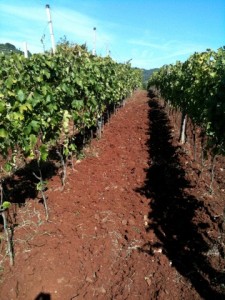
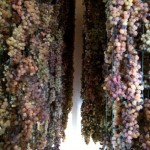
Hello Joseph. Great and interesting read as always. Are the Biancara wines available in Norway ? I have never tried but but have been very curious about them for a while. I visited Alessandro Sgaravatti at Castello di Lispida and he spoke very well of the wines ?
Hello Ingvar,
Thanks for your comment! Maule’s wines are now available in Norway, and you are correct, the wines are very good! They are made from high quality, ripe fruit growing on volcanic soil, producing wines of great depth, freshness and minerality. I will email you the info on how to get them in Norway!
Cheers,
Maule’s wines are not yet available through Vinmonopolet, but can be ordered directly from the importer (whose contact details can be provided through Joseph). It is quite likely that some of these wines will reach Spesialbutikkene later this year.
Apart from the Masieri Rosso, the white Masieri is also an excellent wine in its cathegory, and should be an even better price. Both wines in the present vintage (2009) are the best ever. Rising in complexity, the bigger whites; Sassaia and Pico, are made with longer skin maceration than the Masieri and so have more unusual aromas. While the “simple” Masieri works as a “regular white wine”, these approach “orange wines” and are extremely useful to accompany contrast-rich food. I have had the 2008 Sassaia with raw tuna tartar with capers and pure chocolate – few other wines would have married this dish.
There is also a late-vintage off-dry white called Taibane, interesting and mainly a wine to appreciate on its own, and, of course the sweet Recioto.
The bigger reds; the Merlot, the Ca’naa (Cabernet) and the Sassò (Tocai Rosso) are concentrated, massive fruit-driven wines of great pleasure.
By the way, the same importer is also presently evaluating Castello di Lispida, and Lispida wines are also being evaluated by Vinmonopolet in their very interesting campaign to bring more natural wines onto the Norwegian market.
I have recenty tasted Alessandro’s whites Terralba and Amphora in the just-to-be released 2007 vintage, and they are both very good. Both have marvellous ageing potential, and should be well-aired before drinking (the Terralba was actually much better after 3-4 days open). I still have the 2000 Terralba in the cellar, and that wine only started opening up two years ago – it now drinks marvellously.
Alessandro also makes some interesting reds in a leaner style than Angiolino, and a curious sparkling wine from Tocai grapes. From the 2010 vintage he will experiment with bottle re-fermentation of this wine.
Finn,
Thank you for your comments.
Cheers,
Joseph
Hi guys!
now I know where you are, Joseph. When I got more time I watch better this blog!
thanks for all in Bergen, see you soon
Francesco
Ciao Francesco,
Thank you too for coming up to visit us, I hope too much time won’t pass until the next time we can share a glass together!
Saluti,
[…] section, there are some other new wines i should mention here. Like my first 100 % Merlot wine, the Rosso Masieri. Also produced by the outstanding natural wine maker Angiolino Maule of La Biancara (the same […]
Currently drinking the 2007 Rosso Masieri, brilliant wine, also lots of minerality, nervous but perfectly structured, in the nose soil and heaps of black pepper of a superior kind; in the mout complex, fresh, complex and long, very refreshing but also quite deep and long; lovely; you made an interesting remark about Bordeaux, maybe this is how merlot would taste there if treated the same way, I see the link
Erik!
Thank you for your comment and tasting notes! I appreciate reading the prospective of another wine lover on this wine! I am still enjoying this wine heaps at work.
If you haven’t tried the April 2010 bottling of the 2009 Sassaia, you should try this wine. It’s my favorite wine Maule! I will most likely do a tasting note on it soon because it is one of my favorite white wines of all time. A very mineral white wine with two days of skin contact make this wine funky and drinkable
cheers!